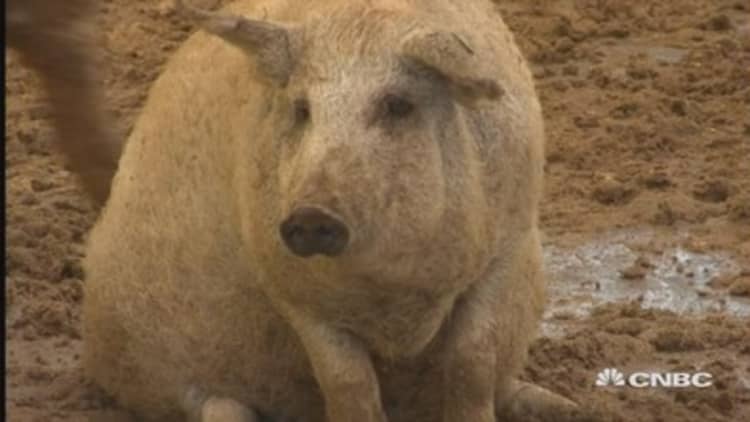Chris Andersen has spent a lifetime raising money on Wall Street. Now he's raising pigs.

Andersen has spent the last eight years investing in and experimenting with raising Mangalitsa pigs, considered the "Kobe beef of pork."
"This, of course, is the blonde," Andersen said as he bent down to pet a pig with long, curly hair. "They say they have more fun. They also have more fat."
Mangalitsas are native to Austria and Hungary, and they come in three colors—blonde, red and black. They have higher fat content than most pigs, but Andersen said it's healthier, monounsaturated fat. "The Mangalitsa never gets diabetes," he said.
Read MoreLandowners square off in California over water meters
After getting his first pig in 2007, Andersen has grown his operation based in Branchville, New Jersey, to become the largest breeder and producer of Mangalitsa pork in the United States. He now has 4,500 pigs over seven farms in three states. His pigs have been USDA-certified as 100 percent Mangalitsa, and Andersen is currently battling with the agency to be able to market lard from the pigs as "Mangalitsa butter."
The goal is to get people to understand how absolutely, pardon the expression, screwed up our food chain is. I can sell you a Mangalitsa collar steak and get you a piece that's 5 to 6 ounces and you'll eat that, and you'll be full like you would if you had an 18-ounce beef steak.Chris AndersenU.S. breeder of Mangalitsa pigs
Andersen knows a thing or two about battling the government. Twenty-five years ago, he ran the New York office of Drexel Burnham Lambert, an investment banking firm that was accused of illegal activities involving junk bonds. The investigation eventually sent Michael Milken to prison, and Andersen said he spent millions fighting the feds until they dropped all charges against him.
"I have reason on occasion to think that the government isn't perfect," he said, "and I've also been in New York long enough that I've become arrogant."
But raising pigs?
Read MoreA disease is wiping out Italy's olive trees
Andersen said it wasn't until after he tasted Spanish hams in Europe that he realized there might be money to be made in bringing that kind of pork to America.
"I can get guns, I can get drugs, I can get boys, I can get girls—you couldn't get a Spanish ham in New York City," he joked. So he decided to take action. "I said to my chef that I may be a dumb investment banker, but I can raise a pig."
It hasn't been easy. Andersen said it took years to find the right pig and the right pig food before he was finally satisfied. His Mosefund Farm now sells the pork to high-end restaurants like Eleven Madison Park and Union Square Cafe. Andersen said he believes he will finally start operating in the black by the end of this year, after spending "over seven digits annually pretty easily."
Raising a Mangalitsa pig can cost three times as much as a regular pig. It takes 15 months to raise one to market weight, compared to five months for conventional pigs. The feed is more expensive—"more like what they have in nature, which is 8 ½ percent protein as opposed to 16 percent protein"—and Andersen insists his pigs be processed by hand.
He's learned a thing or two, however, about marketing. For example, Andersen was trying to sell the neck steak for $8.25 a pound. He failed: "I'm saying, 'This is crazy,' it may be the best piece of meat I've ever had in my mouth, and people won't buy it."
Read MoreAn interactive map of dismal US snowpack levels
So he changed the name to "collar steak" and doubled the price. "I can now sell it for $17 a pound to white tablecloth restaurants," he said, "and I can't keep it in stock."
Andersen has secured a place to dry and cure his product in New Jersey, and he's working with the USDA to label that product for market. His website sells product direct to consumers, including bacon, bratwurst, tenderloin and ground pork. (This reporter sampled sausages and burger patties and didn't feel the need to eat for the rest of the day.)
"The goal is to get people to understand how absolutely, pardon the expression, screwed up our food chain is," he said. "I can sell you a Mangalitsa collar steak and get you a piece that's 5 to 6 ounces and you'll eat that, and you'll be full like you would if you had an 18-ounce beef steak."
Andersen said another goal is to network his contacts from Wall Street to scale up the operation to the next level. "If I can get this under your nose and into your mouth," he said, "you're hooked."


